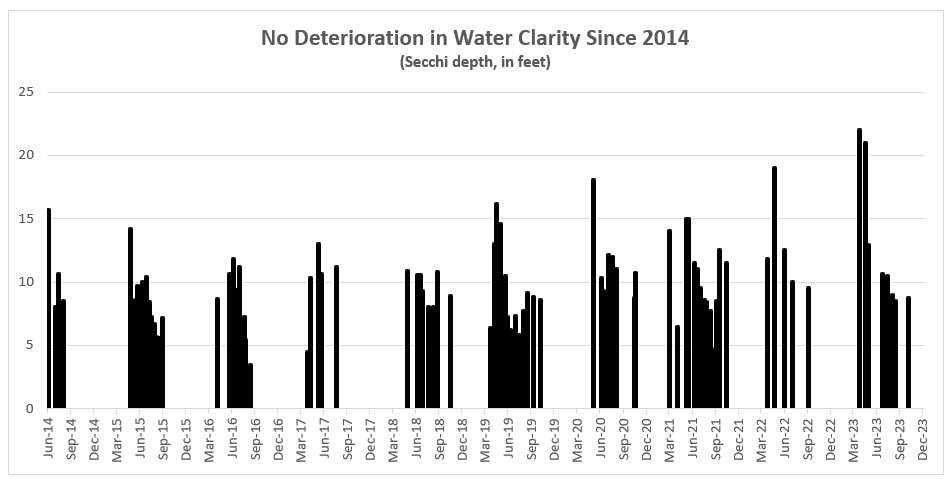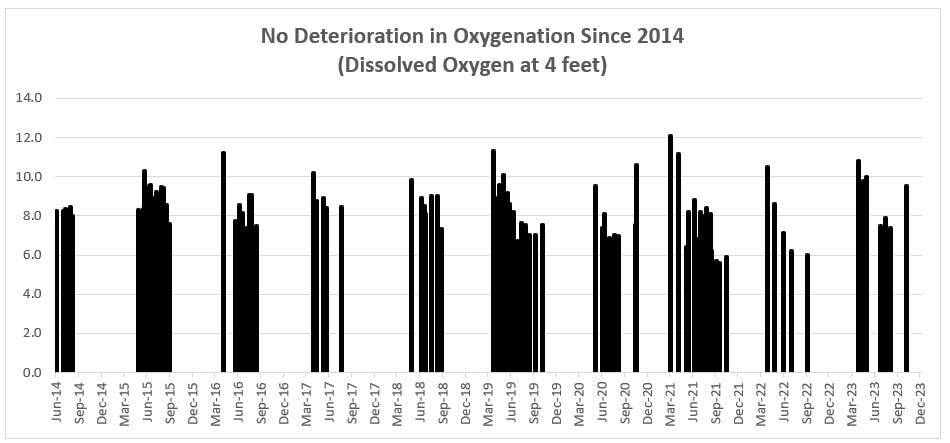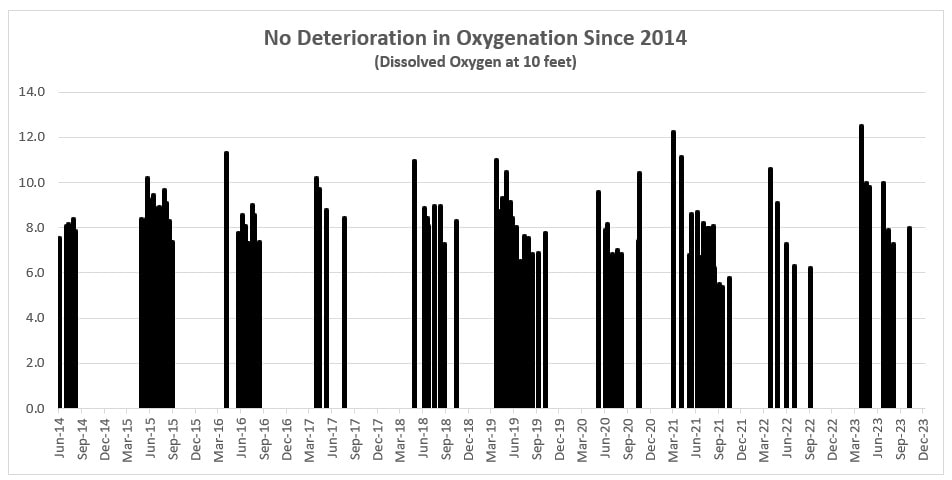2024 Water Testing Has Begun!Volunteers for the Crystal Lake Conservancy have begun the 2024 testing of the Lake starting in April. Last year, tests for clarity of the lake and for dissolved oxygen indicated that the lake is in good shape. Clarity is measured by a Secchi disc, and gave a record depth of 22 feet last spring – the season when clarity is highest. By fall, Secchi fell to 8.5 feet, consistent with previous seasons. There were no notable changes in levels of dissolved oxygen, and no algae was observed – in stark contrast to some other lakes in the state. Water temperature topped out at 82F on July 17th.
Throughout the year, volunteers will be testing clarity and oxygen regularly, and occasionally testing for bacteria and dissolved nutrients, such as nitrate and phosphorous. High levels of nutrients can be predictive of an imminent algae bloom Monitoring ProceduresSince 2010 our dedicated volunteers have continued to take visibility and temperature readings at various sites and depths around Crystal Lake. To carry out their work, volunteers launch into the lake in a rowboat, equipped with a GPS device, laminated maps, thermometers, secchi disks, reporting sheets and markers, To test water visibility, volunteers use a “Secchi disk”, which is an 8-inch disk with alternating black and white quadrants used.
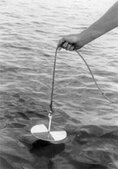
They lower the disk into the water until it can no longer be seen by the observer. This depth of disappearance, called the Secchi depth, is a measure of the transparency of the water. Transparency of the water decreases as color, suspended sediments, or algal abundance increases. Transparency can be an indicator of the impact of human activity on the land surrounding the lake. If transparency is measured through the season and from year to year, trends in transparency may be observed. Transparency can serve as an early-warning that activities on the land are having an effect on a lake.
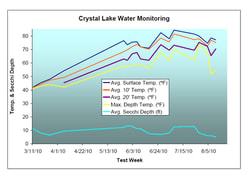
To measure water temperature, volunteers used water-proof thermometers at 3 different depths in 6 different locations around the lake. Water temperatures are an important factor for the health of the lake. As water temperature rises, its ability to dissolve oxygen reduces. At lower temperatures, water will dissolve greater levels of oxygen. Diverse populations of micro-organisms as well as fish rely on a supply of oxygen. Without oxygen, filter bacteria cannot oxidize (and detoxify) ammonia into nitrite and then into nitrate. If a pond or filter are allowed to become oxygen deficient for any period of time, anaerobic conditions will prevail causing unstable water conditions and the tell-tale bad-egg smell. Water Temperature can also affect fish metabolism. The metabolic rate of fish is dependant on water temperature. In winter their metabolism slows right down and speeds up as the water gets warmer in spring. This dependence on water temperature also affects their immune system, wound healing and digestion.
The chart above shows changes and trends in water temperature between March and August of 2010. |
CLC Water Monitoring Program shows water quality at Crystal Lake has maintained high level since 2014The attractiveness of Crystal Lake for uses of all kinds has continued to grow, with record numbers of people enjoying the lake in recent years – a growth accentuated by COVID as people wanted to cool off in outdoor, socially-distanced way. 2024 could set a new record for human enjoyment of the Lake, given the re-opening of Levingston Cove (closed in 2023).
The good news is that the CLC monitoring program has shown no deterioration in water quality since the early part of the last decade. We venture out in a rowboat from April through November to test for temperature, clarity, dissolved oxygen, E. Coli and Enterococci and nutrients (the latter three contracted out to a lab). Please note that the City also tests the water weekly near the swim area during the June to the August season for bacteria. City results are available if you click on this link . There have been, and will likely continue to be, occasional algal blooms in Crystal Lake, as there are in many shallower and warmer bodies of water in Massachusetts that are nearby to development. The City of Newton treated the lake in May 2020 and May 2022 with aluminum sulfate. Since then, there has been only one very minor algal bloom, in late September of 2022. The last major (but brief) blooms were in September 2106 and August 2019. The City’s catch basin filter program (began 2013) repair of the sewer lines (2014) near the lake have also likely contributed to the lake’s stability. Neither the CLC nor the City can detect any detriment to the Lake’s water quality even with the increased use. Our monitoring program will continue to serve as an early alert system should things change. Below are graphs of water clarity and oxygenation since 2014. Historical data regarding bacteria and nutrients is available as well -- it also shows (with only isolated and occasional exceptions) little change since 2014. |
Crystal Lake Conservancy
